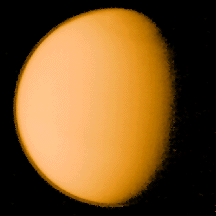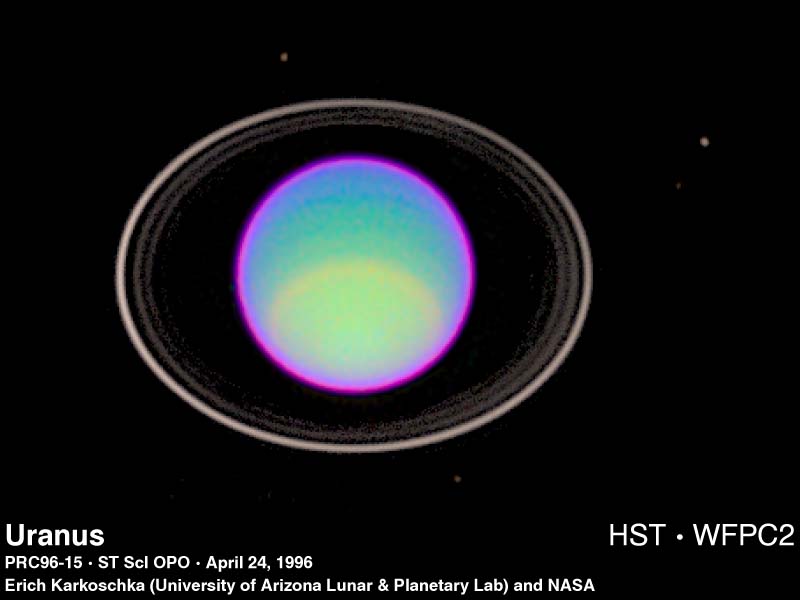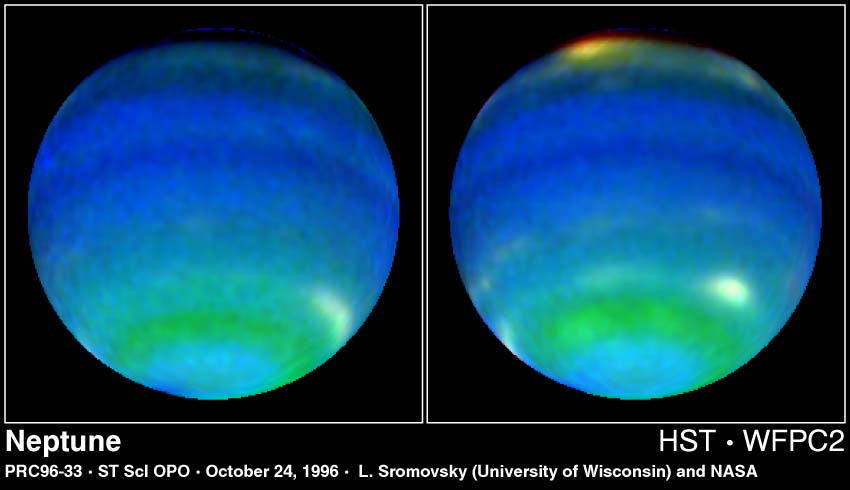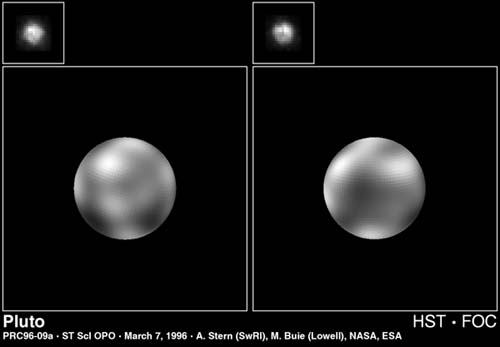 Properties Saturn's Satellites
All have densities between 1.2 to 1.4 g/cm3
except Titan which has 1.9
Compare Jupiter's Galilean Satellites at 1.9 for Europa and Ganymede
3.5 for Io and 3.0 for Europa
NAME DISTANCE FROM SATURN ORBIT PERIOD SIZE
(planet radi) (days) (diameter, km)
Cassini Div 2.04 0.47
Pan 2.22 0.57 20
Enke Div 2.27
A-ring Outer 2.28 0.60
Atlas 2.28 0.60 37 At the Edge of the A Ring
Prometheus 2.31 0.61 148 shepherding satellite of F Ring
F-Ring 2.34
Pandora 2.35 0.63 110 Shepherding satellite of F Ring (ART)
Epimetheus 2.51 0.69 138
Janus 2.51 0.69 199
Mimas 3.08 0.94 398 Large Crater 'Herschel'
Enceladus 3.95 1.37 498 Ice Volcanism (100% albedo)- Cratering
faint E-Ring from emissions
Calypso 4.89 1.89 30 L4 Point of Tethys and Saturn
Telesto 4.89 1.89 30 L5 Point of Tethys and Saturn
Tethys 4.89 1.89 1060 Cratered Geologic Ice Surface
Dione 6.26 2.74 1120 Cratered Ice Surface
Helene 6.26 2.74 32
Rhea 8.74 4.52 1530 Cratered Ice Surface
note jump in orbit radii
Titan 20.3 16.0 5150 Obscured by its dense atmosphere*
Hyperion 24.6 21.3 370 Chaotic Rotation due to nearby Titan
Iapetus 59.1 79.3 1440 Dark leading face (3% albedo) Tailing (50%)
another jump in orbit radius
Phoebe 215 550* 230 Retrograde Orbit
* Titan's Atmosphere = 90% Nitrogen, 10% Argon, Trace Hydrocabons including Methane
Properties Saturn's Satellites
All have densities between 1.2 to 1.4 g/cm3
except Titan which has 1.9
Compare Jupiter's Galilean Satellites at 1.9 for Europa and Ganymede
3.5 for Io and 3.0 for Europa
NAME DISTANCE FROM SATURN ORBIT PERIOD SIZE
(planet radi) (days) (diameter, km)
Cassini Div 2.04 0.47
Pan 2.22 0.57 20
Enke Div 2.27
A-ring Outer 2.28 0.60
Atlas 2.28 0.60 37 At the Edge of the A Ring
Prometheus 2.31 0.61 148 shepherding satellite of F Ring
F-Ring 2.34
Pandora 2.35 0.63 110 Shepherding satellite of F Ring (ART)
Epimetheus 2.51 0.69 138
Janus 2.51 0.69 199
Mimas 3.08 0.94 398 Large Crater 'Herschel'
Enceladus 3.95 1.37 498 Ice Volcanism (100% albedo)- Cratering
faint E-Ring from emissions
Calypso 4.89 1.89 30 L4 Point of Tethys and Saturn
Telesto 4.89 1.89 30 L5 Point of Tethys and Saturn
Tethys 4.89 1.89 1060 Cratered Geologic Ice Surface
Dione 6.26 2.74 1120 Cratered Ice Surface
Helene 6.26 2.74 32
Rhea 8.74 4.52 1530 Cratered Ice Surface
note jump in orbit radii
Titan 20.3 16.0 5150 Obscured by its dense atmosphere*
Hyperion 24.6 21.3 370 Chaotic Rotation due to nearby Titan
Iapetus 59.1 79.3 1440 Dark leading face (3% albedo) Tailing (50%)
another jump in orbit radius
Phoebe 215 550* 230 Retrograde Orbit
* Titan's Atmosphere = 90% Nitrogen, 10% Argon, Trace Hydrocabons including Methane
Cassini Probe to Saturn Due in 2004 Present position of Cassini View from Cassini back toward Earth The Huygen Probe to Drop into the Atmosphere of Titan The Shedule of Cassine when it gets to Saturn

 URANUS-NEPTUNE-PLUTO Physical Data
Uranus Neptune
Semi-major
axis 19.19AU 30.06AU
Solar Flux 3.6 W/m2 1.5 W/m2
Radius 25,559 km 24,764
(4.01 RE) (3.88)
Mass 24.5 MEarth 17.1
Density 1.29 Water 1.64
g(surface) 0.79 gEarth 1.12
VESC 21.3 km/s 23.3 km/s
axial tilt 97.9o 29.6o DIAGRAM OF URANUS TILT
Teff 59 K 59 K (Neptune 7 K warmer than expected)
Core (rock) 7500 km 7000 km Both Planets are more compact than expected
Liquid Mantle for gas giant planets. Must have large rocky
Boudary core. DIAGRAM OF INTERIOR COMPARED TO OTHER
Atmosphere
H2 90% 87%
He 9% 12%
CH4 1% 0.5%
COMPARISON OF JOVIAN MAGNETIC FIELDS
Surface Magnet Tilt Ofset
Field Dipole (deg) (planet
radius)
Jupiter 4.0 G 17000 10 0.1
Saturn 0.2 500 1 0.0
Uranus 0.3 50 60 0.3
Neptune 0.2 30 55 0.5
Earth 0.3 1 11 0.0
DIAGRAM OF MAGNETIC FIELD GEOMETRY
PLUTO NEXT
URANUS-NEPTUNE-PLUTO Physical Data
Uranus Neptune
Semi-major
axis 19.19AU 30.06AU
Solar Flux 3.6 W/m2 1.5 W/m2
Radius 25,559 km 24,764
(4.01 RE) (3.88)
Mass 24.5 MEarth 17.1
Density 1.29 Water 1.64
g(surface) 0.79 gEarth 1.12
VESC 21.3 km/s 23.3 km/s
axial tilt 97.9o 29.6o DIAGRAM OF URANUS TILT
Teff 59 K 59 K (Neptune 7 K warmer than expected)
Core (rock) 7500 km 7000 km Both Planets are more compact than expected
Liquid Mantle for gas giant planets. Must have large rocky
Boudary core. DIAGRAM OF INTERIOR COMPARED TO OTHER
Atmosphere
H2 90% 87%
He 9% 12%
CH4 1% 0.5%
COMPARISON OF JOVIAN MAGNETIC FIELDS
Surface Magnet Tilt Ofset
Field Dipole (deg) (planet
radius)
Jupiter 4.0 G 17000 10 0.1
Saturn 0.2 500 1 0.0
Uranus 0.3 50 60 0.3
Neptune 0.2 30 55 0.5
Earth 0.3 1 11 0.0
DIAGRAM OF MAGNETIC FIELD GEOMETRY
PLUTO NEXT
